On Quincy Jones and the Legacy of 'The Wiz'
Excerpts from Celebrate Brooklyn’s recent panel on Sidney Lumet’s 1978 classic and Quincy Jones, moderated by our very own Dylan Green.

The first time I ever interacted with music from The Wiz was in fourth grade, when I was in my elementary school’s choir and our teacher had us sing its most popular song, “Ease On Down The Road”. I hadn’t seen the movie or the stage musical at the time, but the song stayed with me, and I appreciated it even more when I first saw the film years later. So many of its songs (“No Bad News,” “You Can’t Win,” “What Would I Do If I Could Feel?”) are standards in the pop canon today, and it remains a load bearer for the art of musicals, especially for Black audiences.
That’s why I was so excited to receive the call from our good friends at Celebrate Brooklyn to moderate a panel dedicated to The Wiz, as part of their Quincy Jones tribute series. In late July, at the Lena Horne Bandshell in Prospect Park, I convened with Schele Williams, the director of the version of The Wiz stage show currently touring the country; Bobby Wooten III, a musician who’s worked with everyone from Jennifer Lopez to Carly Rae Jepsen to Mac Miller and is currently an associate arts professor at NYU’s Clive Davis Institute; and Dede Ayite, a Tony Award-nominated costume designer. We spoke about the music, costumes, and story of The Wiz, and its legacy as a love letter to Blackness in all its forms.





